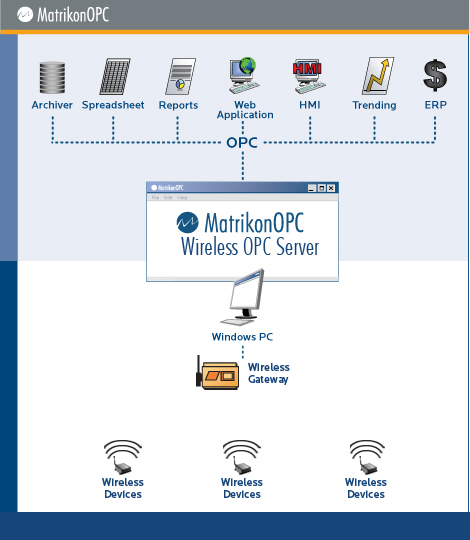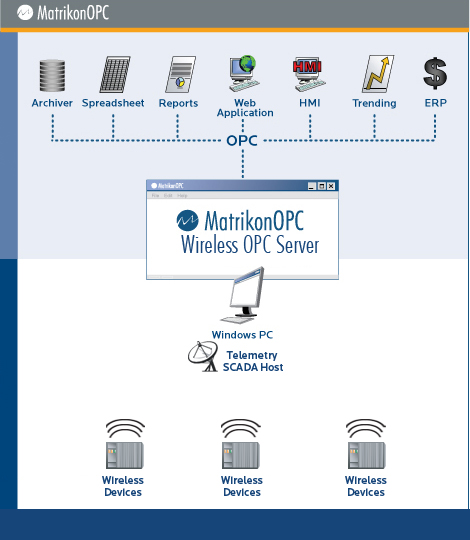Wireless OPC
A short overview of wireless technologies in use today with OPC.
Wireless monitoring of instrumentation sensors such as temperature, flow,
pressure, voltage, current, levels, weight, speeds, revolutions and others is a
common requirement in the control industry. The term 'wireless' is used for any
system used to transfer of information over a distance without the use of
electrical conductors or 'wires'. The distances involved may be short (a few
meters) like with a television remote or long (thousands or millions of
kilometers) for radio or satellite communications. Wireless OPC solutions exist
to meet all needs.
| Short Distance - Wireless Industrial
Gateways |
Technologies:
HART
Bluetooth
ZigBee
|
More information on:
|
|
 |
|
| Long Distance - Wireless-Ready OPC Servers |
Technologies:
Cellular based technology (GPRS/CDMA)
Satellite (Microwave)
Radio
Telephony (dialup)
|
More information on:
|
|
 |
The Wireless LAN
Wireless communications is becoming increasingly popular for factory and
process control automation systems LANs. Wireless infrastructure reduces
installation costs, and provides information for production and maintenance
workers wherever it's needed. This growth is a result of emerging reliable
radio frequency technologies capable of handling the extreme conditions present
in industrial plants.
WiFi
The most well known wireless technologies is WiFi or W-LAN. WiFi connections
are built on the IEEE 802.11x standards which support a wide range of
distances. Architectures using directional antennas can create ranges of
several kilometers or more with line-of-sight. Wi-Fi technology within business
and industrial sites increasing include Wi-Fi access-points that provide
redundancy, support for fast roaming and increased overall network-capacity.
Some applications may utilize true mesh topologies. Also these Wi-Fi
installations may provide secure computer networking gateways, firewalls, DHCP
servers, intrusion detection systems, and other functions, comparable to LAN
architectures.
Personal Area Networks
The term Personal Area Network or PAN has become popular for describing
Wireless connectivity within a very limited distance. An example is Bluetooth,
which supports connections within a range of approximately 10 to 100 feet.
Bluetooth supports serial communications between devices. To support TCP/IP
over Bluetooth, Point-to-Point Protocol (PPP) may be used. With TCP/IP support,
OPC connections may be run over Bluetooth.
OPC and the Wireless Network
In order to extend OPC connectivity beyond a wired LAN, complementary
technology that effectively supports DCOM-style interfaces across wider network
connections is needed. All that is required to support such technology is a
TCP/IP-capable layer, which extends OPC communications over wireless networks.
For many applications there is little difference between communicating over a
LAN verses a WLAN. However, when using OPC the following items should be
considered:
Availability: As wireless communication systems become more common,
customers are expecting the same level of service, availability, and
performance from the wireless communication networks as the traditional
wire-line networks. Products like the Matrikon OPC Tunneller are designed to
improve the availability of OPC communications and reduce lengthy
interruptions.
Bandwidth: Another consideration is the bandwidth required for DCOM
communications. Matrikon OPC Tunneller also reduces the communications
overhead used in standard OPC connectivity.
Reliability: The remote nature of wireless networks means that prolonged
disconnections can occur. Architectures that require guaranteed data delivery
would use OPC HDA based Hub and Spoke solutions.
|